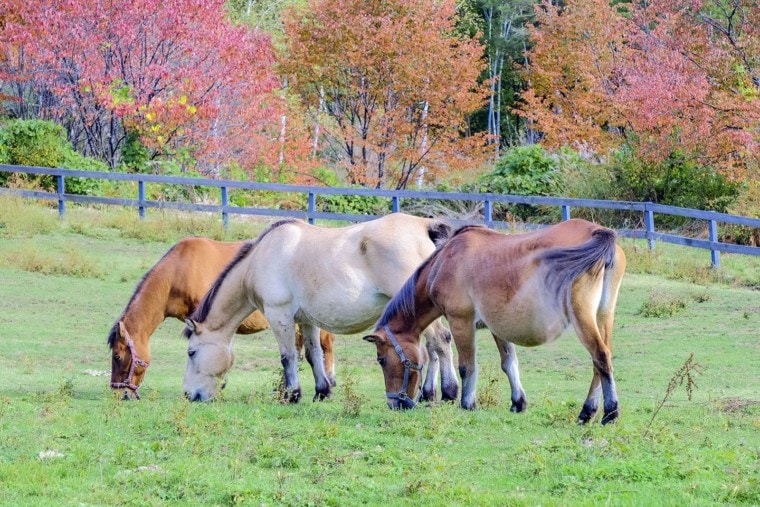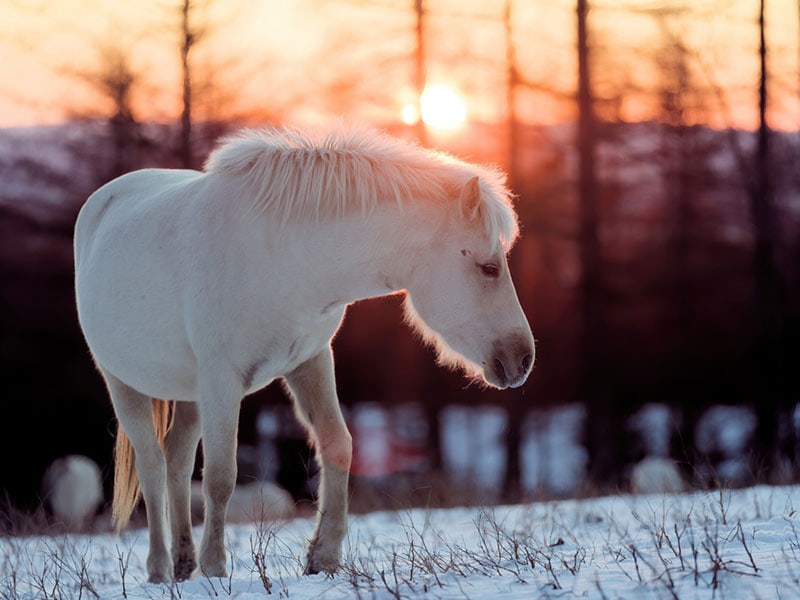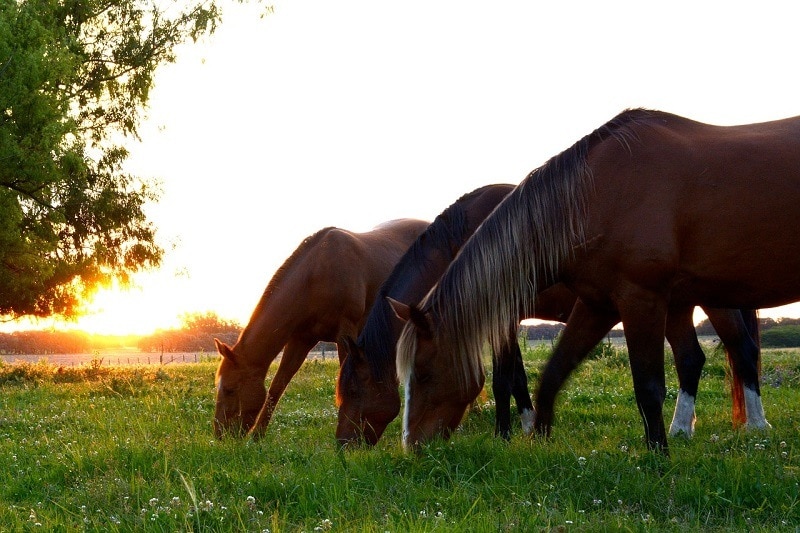
Many animals are typically associated with Japan, some real and others mythical. Horses, however, are not generally included on the list. But horses do have a deeply rooted history in Japan, having first arrived on the island from Mongolia between the third and sixth centuries BCE. That said, there are good reasons why most people don’t picture horses when thinking of Japan’s native animals.
Although several breeds originate in Japan, most of them are endangered or vulnerable, and many more are now extinct. Nine Japanese breeds currently remain, though many have been crossed with more familiar Western breeds. Even still, some of these breeds exist in astonishingly low numbers.
The 9 Japanese Horse Breeds
Officially, there are eight pure horse breeds remaining in Japan. There are also special breeds that aren’t purely Japanese but are the result of crossing Japanese breeds with western ones. They can only be found in Japan, so we’d still consider them to be Japanese breeds.
1. Dosanko

Dosanko horses also go by another name that you might hear more often, Hokkaido. They’re very small horses and are generally classified as ponies, standing at about 13 hands tall on average. Of all the official Japanese breeds, Hokkaido ponies are the only breed that isn’t considered endangered. In fact, about half of all surviving Japanese horses are Hokkaido ponies.
Part of the reason for this breed’s success is that they’re very hardy, sturdy horses. They have no problem surviving Japan’s harsh winters, and they’re well suited for the tough Japanese terrain on which they live.
Dosankos are known for their willing temperament, which makes them perfect for all sorts of work, including military transport, heavy pulling, farm work, and they’re even used for pleasure riding. Most commonly, Dosanko horses are roan-colored, but they do come in many other solid colors as well.
2. Kadachime

Kadachime horses are not a pure Japanese breed. They’ve been crossed with western breeds to create larger horses, as was the mandate during the Meiji period. However, you can see wild Kadachime horses if you head to Cape Shiriya on the northeastern tip of Honshu island.
This breed, despite not being a pure Japanese breed, is designated as a national treasure. Despite efforts to breed them with larger western horses, they’re still rather short, though they have stout, muscular builds and are known for their incredible resilience to cold.
Like many Japanese breeds, they nearly went extinct. In 2009, there were a mere seven Kadachime horses remaining. Today, thanks to increased protection, their numbers have expanded to about 40 horses.
3. Kiso

Kiso horses are from Nagano, which is situated on the Japanese island of Honshu, which is the largest and most heavily populated of Japan’s islands. The Kiso horse is the only breed considered to be native to the island of Honshu. Like most of the Japanese breeds, Kiso horses were practically wiped out by the Edo mandate during the Meiji period. However, the breed still exists due to a single stallion that escaped gelding.
All of the Kiso horses in Japan are domesticated, and they all continue to survive thanks to efforts by the Kiso Uma no Sato, which is a center dedicated solely to the conservation and continuance of the Kiso breed.
At this center, you can see the few remaining Kiso horses. Furthermore, for the right price, you can even ride them! It costs 2,000 yen to ride a Kiso horse for just 15 minutes, but the money helps to keep the breed alive. Currently, there are just 30 of these horses remaining.
4. Misaki

In Japan, you can find both domesticated and wild Misaki horses. You’re most likely to see Misaki wild horses on Cape Toi, located on the island of Kyushu, where they live in a national park. These horses are used to humans, but they’re wild animals. While you can observe the horses in the wild at the national park, you cannot touch them and should never approach one.
Standing at an average of 12 hands in height, these horses are very small and would be considered ponies in the west. When the Akizuki family of the Takanabe Clan gathered up many feral horses for breeding stock in 1967, it became the official start of the breed. though it’s believed that they are descended from horses first brought to the region about 2,000 years ago.
In 1953, the Misaki breed was named a Japanese National Treasure. But they were so low in numbers that in 1973, just 20 years later, there were only 52 Misaki horses left in existence. Thankfully, they’re making a comeback, albeit, quite slowly. Presently, there are approximately 120 Misaki horses remaining.
5. Miyako

The Miyako breed is an ancient breed that has survived for millennia. They’ve even endured through world wars and the Edo mandate, though the breed is facing the very serious threat of extinction. It’s unknown how many Miyako horses remain today, but their prospects aren’t looking great. As of 2001, just 19 Miyako horses remained. This is up from the seven individuals that were alive in 1983, but restoration efforts are moving at an agonizingly slow pace.
Traditionally, Miyako horses were quite small in stature, and most often they were used for farming. Around the time of WWII, the breed started being crossed with imported stallions in an attempt to increase their size. While this did help to make Miyako horses much larger, about 14 hands on average, it didn’t do much to help the breed survive, as numbers began falling rapidly after WWII.
6. Noma

Noma horses are tiny in height at just 11 hands on average. However, they’re rather sturdy animals, especially considering their compact size. They’re also known for their agility. Traditionally, they were used mainly as pack animals since they can carry quite a bit of weight but don’t require too much food due to their small size. But today, they’re essentially just a tourist attraction, though they do occasionally see use as therapy horses for kids.
This breed hails from Shikoku island. They’re originally from a specific district on the island that used to be called Noma, hence, the breed’s name. Larger members of the breed were used by the military, while smaller horses were given to farmers that mostly used them as pack animals.
Though the breed once flourished, their numbers began falling drastically when the breeding of small Japanese breeds was forbidden in an attempt to increase their size by cross-breeding them with larger western breeds. In 1978, there were only six individual Noma horses left on the planet. The Japanese government funded a reserve for the breed in 1989 to increase their numbers. Their numbers multiplied, and in 2008, there were a total of 84 Noma horses.
7. Tokara

The Tokara breed was originally known as Kogashima because the breed hails from the Kogashima region of the Tokara Islands. They were first found in 1952, and their discovery was so important that they were immediately labeled as a National Monument of Kagoshima. When discovered, only 43 Tokara horses existed. Unfortunately, due to mechanization, their numbers started to decline right away. By 1974, only a single Tokara horse remained on the island.
Thankfully, that’s not the end of the breed’s story. That sole Tokara horse was transported to Nakanoshima, where a few Tokara horses existed that had been previously removed from the Tokara Islands. Thanks to concentrated breeding efforts, their numbers multiplied, and today, there are more than 100 Tokara horses.
Tokara horses are sturdy, strong, and hard working. But there is little demand for hard-working horses in Japan, so they’re rarely used for riding, work, or anything else, which is a major reason for the decline of the breed in the first place.
8. Taishu
This breed is rare and extremely ancient. It’s believed that the breed dates back to the 700s. They’re from Tsushima Island, located in the Korea Strait. Since 1979, the breed has been protected and efforts have been ongoing to increase their numbers. Exact numbers of remaining Taishu horses are unknown, however, so it’s hard to gauge how efforts are going.
Standing between 12 and 14 hands, Taishu horses are large for a Japanese breed, though still small by western standards. Traditionally, they were found useful in many ways, including riding, draft work, and as pack animals.
9. Yonaguni

Yonaguni horses largely escaped the Edo mandate that caused the end of many other pure Japanese horse breeds. As such, they’re one of the purest and most ancient of all remaining Japanese breeds. They stand just 11-12 hands in height, having never been crossed with larger western horses.
These horses are shown to be very similar genetically to Miyako and Tokara horses. Today, they’re considered to be critically endangered with only a few remaining specimens, though exact numbers are unknown.
Why Are Japanese Horse Breeds So Rare?
Horses have been in Japan for well over a millennium. But during the Meiji period, which spanned from 1868 to 1912, efforts were undertaken to increase the size of the relatively small Japanese horses by cross-breeding them with much larger breeds from the West. Japan needed large horses for draft work, and this appeared to be the solution.
To that end, pure stallions of Japanese breeds were ordered to be gelded, also known as castration. This order was known as the Edo mandate. Meanwhile, Japanese mares, female horses, were crossed with western breeds to create these new, larger horses. While this did have the intended effect, there was another massive side-effect of the process. By the end of the Meiji era, many of the pure Japanese horse breeds had died out completely, never to be seen again.
Luckily, not every Japanese breed was decimated in this manner. A few select breeds in certain regions of the country managed to escape this fate; mainly, the breeds located exclusively in the southern and northern islands and capes.

Differences Between Japanese and Western Breeds
Every horse breed is unique and has some traits that are exclusively theirs, but all of the Japanese breeds share a few traits that set them apart from the breeds that are traditionally in the west.
For instance, despite efforts during the Meiji period, Japanese horses are still generally much smaller than western breeds. Often, they’re even classified as ponies.
Another major difference is that Japanese breeds have incredibly hard hooves. In the west, horses wear shoes made of metal to protect their feet. But horses in Japan are very rarely shod because their hooves are so hard that they simply don’t require horseshoes. In the coldest areas, some of these horses are provided with boots made of straw, but that’s a far cry from the hard metal shoes we use in the west.
Probably the biggest difference between Japanese horses and western breeds is prevalence. There just aren’t many Japanese horses left. Most of the Japanese breeds are endangered and facing the very real possibility of extinction. To protect them, many of these breeds have been labeled as prefectural treasures, but their numbers are still dwindling.
Wild and Domestic Horses in Japan
Even though the population of horses in Japan is low, you can still find both domesticated and wild horses across the country. Many of the wild horses are found in national parks, where they’re protected and have been living wild for many years. Different regions in the country are home to specific breeds that can only be seen in those places.
For many Japanese breeds, you can find domestic and wild populations. However, some of these breeds are so low in numbers that they’re down to single digits. Thanks to restoration efforts, hopefully, these breeds will make a comeback and not be lost to the world forever.
Conclusion
Horses may not be a creature that you commonly associate with Japan, but they do have a rich and long history in the country. Found across mainland Japan and on many of its coastal islands, there are several remaining Japanese horse breeds, all of which are largely unknown in the west. Though they nearly went extinct due to the Edo mandate during the Meiji period that decreed all stallions must be gelded so mares could mate with larger western breeds, many of these Japanese breeds are making slow, steady comebacks. Hopefully, one day, some of them can be lifted from the critically endangered status that most of these Japanese breeds share.
Featured Image Credit: janken, Shutterstock









